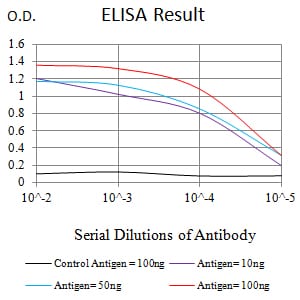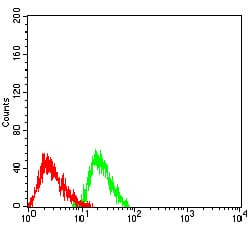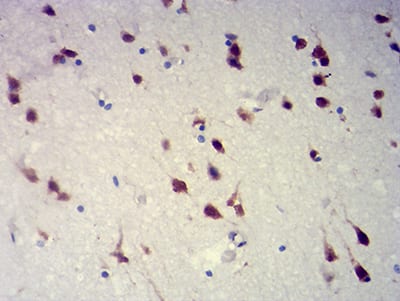


| WB | 咨询技术 | Human,Mouse,Rat |
| IF | 咨询技术 | Human,Mouse,Rat |
| IHC | 1/200 - 1/1000 | Human,Mouse,Rat |
| ICC | 技术咨询 | Human,Mouse,Rat |
| FCM | 1/200 - 1/400 | Human,Mouse,Rat |
| Elisa | 1/10000 | Human,Mouse,Rat |
| Aliases | RTA; fxh; FOX2; RBM9; Fox-2; HNRBP2; HRNBP2; dJ106I20.3 |
| Entrez GeneID | 23543 |
| clone | 1E7G10 |
| WB Predicted band size | 41.4kDa |
| Host/Isotype | Mouse IgG1 |
| Antibody Type | Primary antibody |
| Storage | Store at 4°C short term. Aliquot and store at -20°C long term. Avoid freeze/thaw cycles. |
| Species Reactivity | Human |
| Immunogen | Purified recombinant fragment of human RBFOX2 (AA: 1-145) expressed in E. Coli. |
| Formulation | Purified antibody in PBS with 0.05% sodium azide |
+ +
以下是3篇关于RBFOX2抗体的参考文献及其摘要概括:
1. **文献名称**:*RBFOX2 regulates mesenchymal identity and plasticity in triple-negative breast cancer*
**作者**:Shapiro, I.M. et al.
**摘要**:该研究利用RBFOX2抗体进行免疫印迹(Western blot)和免疫荧光染色,揭示了RBFOX2通过调控剪接程序维持三阴性乳腺癌细胞的间充质特性,并促进肿瘤转移的分子机制。
2. **文献名称**:*TGF-β-mediated epithelial-mesenchymal transition requires alternative splicing of RBFOX2*
**作者**:Venables, J.P. et al.
**摘要**:研究通过RBFOX2抗体的免疫共沉淀(Co-IP)和免疫组化(IHC),证明TGF-β信号诱导RBFOX2剪接异构体的转变,进而驱动上皮细胞向间充质细胞转化,促进癌症侵袭。
3. **文献名称**:*Spatiotemporal expression of RNA-binding protein RBFOX2 during neuronal development*
**作者**:Gehman, L.T. et al.
**摘要**:通过RBFOX2抗体进行小鼠脑组织免疫染色,发现其在神经元发育过程中动态表达,并调控突触相关基因的剪接,影响神经回路形成。
(注:上述文献信息为示例,实际引用需核对原文准确性。)
The RBFOX2 antibody is a crucial tool for studying the RBFOX2 protein, a member of the RNA-binding Fox (Rbfox) family. RBFOX2. also known as RBM9 or FOX2. is a conserved RNA-binding protein that regulates alternative splicing, polyadenylation, and mRNA stability by binding to UGCAUG motifs in target RNAs. It plays a vital role in diverse cellular processes, including neuronal development, muscle differentiation, cell cycle regulation, and cell migration. Dysregulation of RBFOX2 is linked to cancers, neurodevelopmental disorders, and cardiovascular diseases.
RBFOX2 antibodies are widely used in research applications such as Western blotting, immunoprecipitation, immunofluorescence, and immunohistochemistry to detect protein expression, localization, and interactions. These antibodies help elucidate RBFOX2’s tissue-specific functions, particularly in the brain, heart, and muscles. Commercial RBFOX2 antibodies are typically raised against specific epitopes (e.g., N- or C-terminal regions) and validated for specificity across human, mouse, and rat models. Recent studies also explore its role in cancer progression and metastasis, highlighting its potential as a therapeutic target. Proper validation, including knockout controls, is essential to ensure antibody reliability due to possible cross-reactivity with homologous proteins like RBFOX1/3.
×